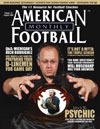AMERICAN FOOTBALL MONTHLY THE #1 RESOURCE FOR FOOTBALL COACHES
Article CategoriesAFM Magazine
|
The Strength Report: The Forgotten Three - The Neck, Traps and Gripby: Ron McKeeferyAsst. Athletic Director, Strength & Conditioning, University of South Florida © More from this issue I have found over the years that training the neck, traps and grip often get missed. When coaches ask me to evaluate programs I look first for those three areas. I assure you that training these three areas both serves to protect the athlete and boost performance. The game of football is a collision sport. The most catastrophic injury in football is one that involves the neck. According to a recent study by the National Center for Catastrophic Sports Injury Research for the Journal of the American Medical Association, over a three-year span there were 61 deaths, 147 permanent disabilities and 166 serious neck injuries of high school athletes. For college athletes there were 5 deaths, 21 permanent disabilities and 62 serious neck injuries. Therefore, as strength and conditioning professionals, we have an obligation to protect our athletes as best we can from injury. When I speak around the country I often ask the audience what is the most important lift in football? Inevitably I get Bench, Squat, Clean, etc. I respond by pointing out the risk involving the neck and ask if they are training for it. NECK The neck is made up of extensors, flexors and lateral flexors. If you are fortunate to have a four-way neck, you can utilize it to train all three areas. However, if you don’t have one you can always use manual resistance. The extensors are trained with the athlete sitting or lying with the resistance placed on the back of the head, the head extending back toward the glutes and back until the chin touches the chest. As we have discussed in prior articles, it is important to remember to train the muscle through the entire range of motion. The flexors are in the front of the neck and are trained by sitting or lying and the resistance being placed on the forehead. Train from full extension to the chin coming up to the chest. Lateral flexors are the muscles on the side of the neck; they are trained by moving the head from shoulder to shoulder with resistance being placed on the side of the head for the side you are training. TRAPS The traps connect to the neck musculature and also help protect the head and neck. Think of building a base for the head and neck to sit into. The larger the base, the stronger the structure. An added benefit to training the traps is its role in many of the Olympic lifts. The small muscle is used in many pulling movements and needs to learn how to be activated and used properly. By training the traps with exercises such as shrugs and upright rows, you will both protect the head and neck and see performance gains in some of your other lifts. GRIPS How many times have we all watched a defender making a game saving tackle by holding on with one hand long enough for the rest of the defense to get there? Every offensive and defensive line coach in the country is coaching their linemen to use their hands. Ball carriers are persecuted by their coaches and teammates if they give up a fumble. However, in many instances, the grip is never trained by those athletes. The response I hear the most is that ‘we train the grip by performing other exercises.’ It is very difficult to determine strength levels of the hands and forearms by chalking it up to being trained by other exercises. At South Florida we train the grip independently of any other exercise. This allows us to determine the current strength level and identify any imbalances from one side to the other. We use exercises such as the Hammer Strength Gripper, wrist rolls, rice bucket, plate holds, plate flips, and hangs for this purpose. Strength and conditioning professionals have an obligation to help protect the athlete from injury. We tell our athletes that every time they cross the sideline they expose their entire body to injury. A neck injury can be catastrophic and thus must receive a great deal of attention. Therefore, make sure you are training both the neck and traps to help protect your athlete. Additionally, don't forget to train the grip as it may be what helps you win that championship. Remember to ask yourself what you are doing in your program for the neck, traps and grip. |
|
| HOME |
MAGAZINE |
SUBSCRIBE | ONLINE COLUMNISTS | COACHING VIDEOS |
Copyright 2024, AmericanFootballMonthly.com
All Rights Reserved




